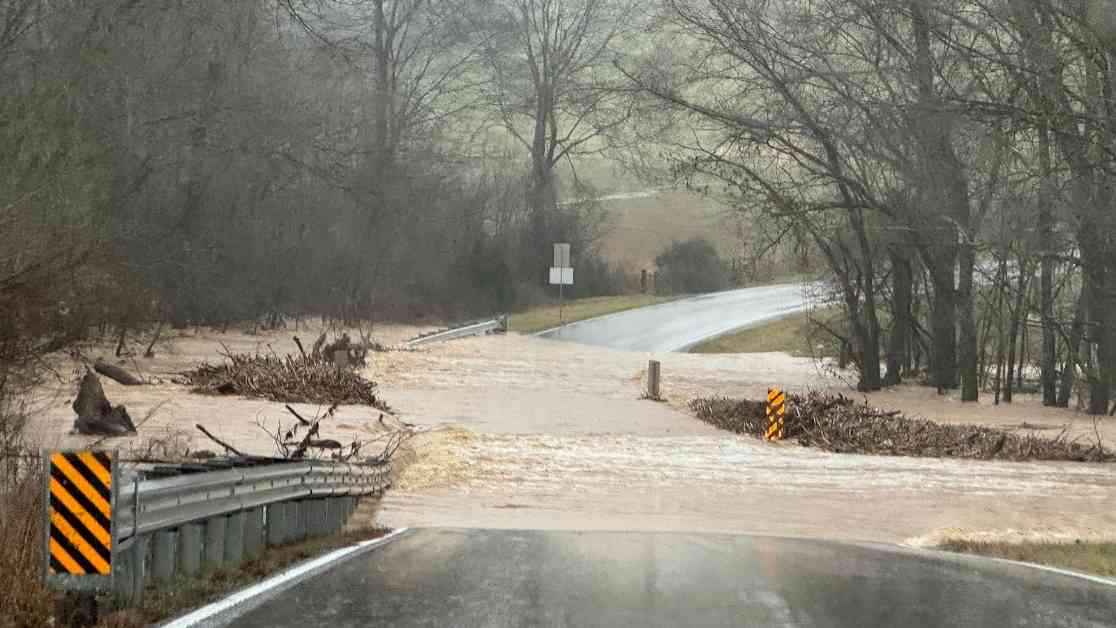Severe Flash Floods in Eastern US: Impact and Response
Heavy rain wreaked havoc across the Southern U.S. on Saturday, resulting in severe flooding that inundated roadways and prompted evacuations in several areas. Simultaneously, the Northeast and Mid-Atlantic regions faced snow and sleet, adding to the chaotic weather conditions.
Flash Flood Warnings were issued throughout Saturday and into the night across Kentucky, Tennessee, West Virginia, and North Carolina, highlighting the widespread impact of the intense rainfall. Governor Andy Beshear declared a state of emergency in Kentucky ahead of the deluge, emphasizing the imminent threat faced by the entire state during the early morning hours.
In Kentucky, the heavy rain led to extensive flooding in various regions, with southern Barren County bearing the brunt of the severe weather conditions. Notably, the area around Panbowl Lake in Jackson, approximately 85 miles southeast of Lexington, witnessed significant flooding that necessitated the evacuation of a nursing home and a hospital as precautionary measures were put in place.
Tennessee also grappled with the aftermath of the flash floods, as over 50 residents of a nursing home in Macon County, situated about 65 miles northeast of Nashville, were evacuated to safer grounds due to rising water levels. The swift response by the Macon County Emergency Medical Services underscored the urgency of the situation and the need to prioritize resident safety amidst the natural disaster.
The National Weather Service issued a flash flood emergency for multiple counties in West Virginia and southwestern Virginia, extending the warning until the early hours of Sunday morning. Describing the flash flooding as “extremely dangerous and life-threatening,” the authorities urged residents to exercise caution and follow evacuation directives promptly to ensure their well-being.
In southwestern Virginia’s Tazewell County, the town of Richlands faced significant flooding challenges, prompting local law enforcement to advise residents in affected areas to evacuate without delay. The rising river levels posed a continuous threat, necessitating proactive measures to mitigate potential risks and safeguard the community from further harm.
As the storm persisted, accompanied by damaging winds and flash flooding, there remained a looming possibility of tornadoes in the region. Residents were urged to remain vigilant and heed severe weather warnings, particularly during the overnight hours when the tornado risk remained prevalent, underscoring the importance of staying informed and prepared for any eventualities.
In a simultaneous weather event, snowfall blanketed portions of the Northeast and Mid-Atlantic regions on Saturday afternoon, with conditions expected to deteriorate as the day progressed. The anticipated transition from snow to sleet and rain heightened concerns over hazardous travel conditions and the need for increased caution on the roadways.
By late evening, warmer air surged northward, resulting in a shift from snow to sleet and rain in New York City, indicative of the dynamic weather patterns at play. As the night progressed, the radar imagery resembled layers of Neapolitan ice cream, reflecting the diverse precipitation types across New England, including snow, ice, and rain, prompting residents to brace for significant accumulations.
The looming threat of high winds added another dimension to the weather forecast, with wind alerts covering more than 86 million individuals across 22 states for Sunday and Monday. As the winter storm system traversed the region, wind gusts of 50 to 60 mph were expected, posing additional challenges for residents and authorities alike in navigating the aftermath of the severe weather conditions.
As the impacted regions grappled with the aftermath of the severe flash floods and inclement weather, the collective response underscored the resilience and preparedness of communities in the face of natural disasters. The coordinated efforts of local authorities, emergency services, and residents exemplified the spirit of unity and solidarity essential in overcoming challenges posed by extreme weather events.
The severe flash floods and adverse weather conditions served as a stark reminder of the unpredictability of nature and the necessity of proactive measures to mitigate risks and protect vulnerable communities from the impact of climate-related disasters. As the affected regions embarked on the path to recovery, the resilience and fortitude displayed in the face of adversity stood as a testament to the unwavering human spirit and collective resolve to weather the storm, no matter how challenging the circumstances may be.


